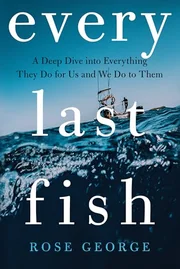
George is the author of Ninety Percent of Everything (2013), a revelatory and unexpectedly funny book about the shipping industry. In her latest work, she returns to the sea to focus on the fishing industry, another subject that, despite the prevalence of seafood, most of us know little about. It’s a startling account; much of what she shares will hit readers like a blast of shoreline wind. The details are unsettling. “Fish for awful statistics about ocean creatures and you will land a giant catch,” she writes. “For every 300 turtles that swam in the Caribbean, there is now one.” Industrialized fishing has been so destructive that “we spend twice as much effort to catch the same number of fishes as we did in the 1950s.” Huge numbers of other creatures are accidentally captured: In this “bycatch”—the industry term is “discards”—300,000 whales and dolphins are killed every year. This doesn’t even take into account illegal fishing. “One in every five fishes imported by Americans is illegally caught,” the author writes. And then there’s the nasty business of unwanted guests that plague salmon farms, leaving fish “half-eaten by lice.” In her travels, George spends time with fishermen in her native Britain. The crew’s blunt humor is evident when she vomits overboard: “More food for lobsters,” they say. In a stirring chapter on bygone “herring girls” who gutted fish hour after hour, George describes how these women fought for better safety. It’s still a dangerous profession: Every year, 100,000 fishermen die on the job. It doesn’t help that in the U.S., there’s a lack of training. Some observers, meantime, have mysteriously lost their lives when reporting on human rights violations. All the while, demand for seafood is rising. “By 2050, our fish consumption is predicted to double,” George writes. “Where will it come from?” It’s little surprise that George herself does not eat fish.

